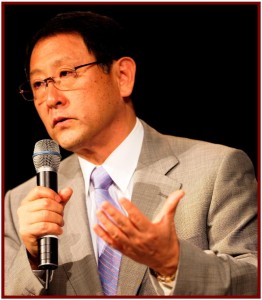Akio Toyoda, president of Toyota Motor Corporation, announced today in Japan a sweeping reorganization of the automaking giant – called Toyota Global Vision – that was prompted by huge operating losses, quality problems and Toyoda’s personal attempt to explain the company before U.S. Congressional hearings on delays in fixing unintended acceleration and stuck gas pedals. The TMC board is being cut from 27 members to 11 to speed decision making.
“As for our series of quality problems, I, personally, played a direct role in explaining to the U.S. Congress, to members of the media around the word, and, to, most of all, our customers, what kind of company we are and what kind of values we hold,” Toyoda said.
“That experience led me to keenly feel anew the importance of making it known to all our customers and to the public at large the direction our company intends to take,” Toyoda said.
Vowing that “Toyota will lead the way to the future of mobility,” Toyoda, the scion of the founding family, said the executive staff would be streamlined – – and more decision making power would now reside in the regions.
The unintended acceleration and stuck gas pedal recalls were only undertaken by Toyota after years of neglect when U.S. Department of Transportation officials flew to Japan and insisted on the safety recalls. U.S. Toyota executives were only responsible for sales matters and were powerless to address the issue. Subsequently, DOT imposed record multi million dollar fines on Toyota for delays in addressing the deadly problem.
The actual Global Vision statement is the usual compilation of corporate speak and clichés, and the presentation was more one of philosophy than actual deadlines for achieving results:
“Toyota will lead the way to the future of mobility, enriching lives around the world with the safest and most responsible ways of moving people. Through our commitment to quality, constant innovation and respect for the planet, we aim to exceed expectations and be rewarded with a smile. We will meet challenging goals by engaging the talent and passion of people, who believe there is always a better way.”
Challenges abound.
First, the quality issues loom large, and the recalls keep coming, with another U.S. recall yesterday. It might take years after the recalls stop for potential buyers to forget. In the interim, Toyota will have to use expensive incentives and rebates to keep sales going, which runs counter to Toyota’s intended profitability goal.
(See Toyota Recalls Trucks For Tire Pressure Monitor Defect and Accelerator Pedal Recall Causes More Lexus and Toyota Recalls! Technicians Did Not Correctly Replace the Carpeting. Original Recall Now Expanded to Include More Toyota Vehicles)
Toyota also wants to rebalance its sales mix from 60% in existing industrial markets to 50% by 2015 by picking up 10% in emerging markets. This means in practical application that there likely will not be new factories in Japan, Europe and North America, with possible contractions. Toyota and Lexus sales are expected to reach 10 million units annually by 2015.
In terms of financial results, Toyota wants to return to an operating profit of 5% of sales (~$12 billion) based on a strong Yen of 85:$1 at unit sales of 7.5 million vehicles annually. This is well below Toyota’s global sales peak in 2007 of a record 8.42 million units. Toyota’s worldwide sales declined in 2008 and 2009 because of the Global Great Recession, but it’s on track this year to sell 7.5 million units.
Toyota posted an operating loss of ¥460 billion in the fiscal year ended March 31, 2009, and posted operating losses of more than $11 billion during the past three years. Toyota is predicting a 2.9% return for its fiscal year ending March 2011.


